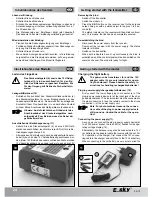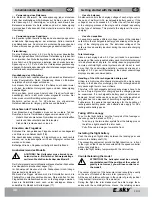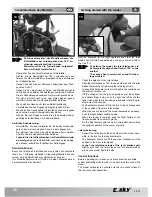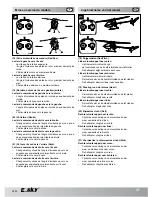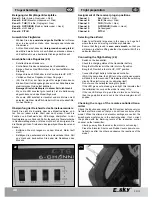
05/10
34
Inbetriebnahme des Modells
Getting started with the model
Es stehen folgende Steuerfunktionen zur Verfügung:
Gas/Pitch-Funktion
Mit Hilfe der Gas/Pitch-Funktion wird die Flughöhe eines
Helikopters beeinflusst.
Die Steuerung erfolgt mit dem linken
Steuerhebel (Gas/Pitch-Hebel).
Dazu kann dieser vor und
zurück bewegt werden, ohne dass er, wie bei den anderen
Steuerfunktionen, immer wieder in die Mittelstellung zurückfe-
dert. Im normalen Heli-Modus erfolgt die Höhenregulierung über
eine Änderung des Anstellwinkels der Rotorblätter (Pitch)
und
über eine Drehzahländerung des Hauptrotors (Gas) von Leerlauf
bis Vollgas.
Im 3D-Modus (Kunstflug) variiert die Drehzahl zwischen
Vollgas an beiden Endausschlägen des Steuerhebels und
Halbgas (Schwebeflug) in der Mittelstellung, ohne über eine
Leerlaufstellung zu gehen.
Heck-Funktion
Die Heck-Funktion bewirkt über eine Drehzahländerung des
Heckrotors eine Drehung des Helikopters um die Hochachse.
Die Steuerung erfolgt ebenfalls mit dem linken Steuerhebel
(Gas/Pitch-Hebel).
Das Drehmoment des Hauptrotors veranlasst den Rumpf zu
einer gegenläufigen Drehbewegung um die Hochachse. Der
Heckrotor, dessen Rotationsebene senkrecht zur Rotationsebene
des Hauptrotors steht, wirkt dieser Drehung des Rumpfes
entgegen. Wird der Gas/Pitch-Hebel nach rechts oder links
bewegt, ändert sich die Drehzahl des Heckrotors. Auf diese
Weise wird mehr oder weniger seitlich gerichteter „Auftrieb“
erzeugt. Wird das Drehmoment des Hauptrotors überkompen-
siert, dreht sich das Heck in die Drehrichtung des Hauptrotors.
Ist der Auftrieb des Heckrotors schwächer als das Drehmoment
des Hauptrotors, dreht das Heck gegenläufig zum Hauptrotor.
Im Geradeausflug kompensiert der Heckrotor exakt das
Drehmoment des Hauptrotors.
Roll-Funktion
Die Roll-Funktion bewirkt ein Kippen des Helikopters um
die Längsachse. Seitliches Kippen des Helikopters leitet den
Seitwärtsflug ein. Der einstellbare Winkel der Taumelscheibe
zur Rotationsachse des Hauptrotors bewirkt eine zyklische
Änderung des Einstellwinkels der Rotorblätter,
die der Pitch-
Einstellung überlagert ist.
Je nachdem, an welcher Stelle des
Umlaufes der größte Anstellwinkel (höchste Auftrieb) erreicht ist,
fliegt der Helikopter vorwärts, rückwärts oder nach einer Seite.
Die Steuerung erfolgt mit dem rechten Steuerhebel.
Wird der
Steuerhebel nach rechts bewegt, ist der Auftrieb auf der linken
Seite des Rotorumlaufes am höchsten. Der Helikopter kippt
nach rechts und leitet eine Rechtskurve ein.
Nick-Funktion
Die Nick-Funktion bewirkt ein Kippen des Helikopters um die
Querachse. Der Pilot kippt die Maschine nach unten, um den
Vortrieb einzuleiten. Wie bei der Roll-Funktion wird dies durch
die Anstellung der Rotorblätter erreicht.
Die Steuerung erfolgt
ebenfalls mit dem rechten Steuerhebel.
Wird der Steuerhebel
nach vorne bewegt, ist der Auftrieb in der hinteren Hälfte des
Rotorumlaufes am größten. Das Heck wird angehoben und die
Nase abgesenkt. Der Helikopter fliegt nach vorne.
The following steering functions are available:
Throttle function
The flight height of a helicopter is affected by the pitch function.
The control is effected with the left control stick.
To that
effect, the control stick can be moved forward and backward.
Unlike with other control functions, the stick does not keep sprin-
ging back to the centre position.
In the normal helicopter mode, the height is regulated by chan-
ging the angle of attack of the rotor blades (Pitch) and the speed
of the main rotor (Gas) from idle running to full throttle.
In the 3D mode (stunt flying), the speed varies between full
throttle for full deflections of the control lever and half throttle
(hovering) in the central position without going into a neutral
„Idle position“, neutral ist irgendwo die Mittelstellung, oder?
position.
Rudder function
The rudder function causes the helicopter to rotate about its
vertical axis via a change in the speed of the tail rotor. The
helicopter is controlled with the left control lever (Throttle
lever).
The main rotor torque brings about a counter rotation of the
fuselage around the vertical axis. The tail rotor with the rotation
level perpendicular to the rotation level of the main rotor reacts
to this fuselage rotation.
Moving the gas/pitch lever to the right or left changes the speed
of the tail rotor. Thus, a lateral „lift“ is generated.
If the main rotor torque is over-compensated, the rudder moves
in the direction of rotation of the main rotor.
If the tail rotor lift is weaker than the main rotor torque, the
rudder moves in the opposite direction to the main rotor. During
the straight flight, the tail rotor precisely compensates the main
rotor torque.
Aileron function
This function causes a tilting of the helicopter around the longi-
tudinal axis. A lateral tilting of the helicopter leads to a sideways
flight. The adjustable angle of the swash plate to the axis of
rotation of the main rotor brings about a cyclic change in the
setting angle of the rotor blades, which is superimposed on the
Pitch setting. Depending upon the position of rotation, where the
highest angle of attack is achieved (maximum lift), the helicopter
flies forward, backward or to a side. The right control lever is
used to control the movement. If you take the control lever to the
right, the lift is highest on the left side of the rotor circulation. The
helicopter tilts to the right and takes a right curve.
Elevator function
The Elevator function tilts the helicopter around the lateral axis.
The pilot tilts the machine downwards and initiates a propulsion.
Like the Aileron function, this can be achieved with the angle
of attack of the rotor blades. You can also use the right control
lever for controlling the helicopter movement. If you take the
control lever to the front, the lift is highest in the rear half of the
rotor circulation. The rudder is lifted and the nose lowered. The
helicopter flies in the front direction.





